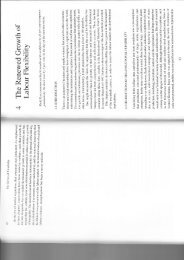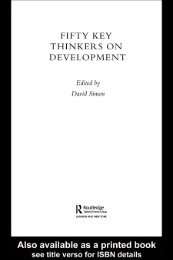GLOBALISATION AND THE THIRD WORLD.pdf - Steerweb.org
GLOBALISATION AND THE THIRD WORLD.pdf - Steerweb.org
GLOBALISATION AND THE THIRD WORLD.pdf - Steerweb.org
Create successful ePaper yourself
Turn your PDF publications into a flip-book with our unique Google optimized e-Paper software.
<strong>GLOBALISATION</strong> <strong>AND</strong> <strong>THE</strong> <strong>THIRD</strong> <strong>WORLD</strong>http://pubs.socialistreviewindex.<strong>org</strong>.uk/isj81/marfleet.htm5 of 25 16/03/2012 21:46UN's Food and Agriculture Organisation (FAO) estimated that 59 million Latin Americans were sufferingchronic hunger. 38 In Asia, 40 years of growth among the Tiger economies had made them models formainstream development strategists. Even before the meltdown of 1997, however, the World Bank noted'a consistent pattern of poverty throughout the region', pointing out that a billion people lived below thepoverty line, including over one third of the population of China. It also noted that inequality in a series ofcountries, especially in South East Asia, was becoming much more pronounced. 39 In October 1998 theUnited Nations Children's Fund (Unicef) reported that malnutrition in some parts of the region, notablyThailand, Indonesia and Malaysia, had reached proportions hitherto associated only with 'the benchmarkof poverty--Africa'. 40 The Philippines government pleaded for massive aid from Western governments,arguing that that for the first time in 20 years, 'the war against poverty...is being lost [sic]'. 41 Even theSingapore government, which has long suppressed all 'bad news' stories, warned of the implications ofunemployment and deepening poverty in neighbouring Indonesia, quoting estimates that half theIndonesian population of over 200 million would be below the poverty line by the end of 1998. 42In the worst affected regions such as the Horn of Africa and parts of West Africa, attempts to stimulateeven basic development have largely been abandoned. Cox comments:The perception that much of the world's population is not needed by the global economy seems tohave been recognised implicitly (though never openly) by the principal world institutions. Policiesto promote economic development have been very largely displaced in favour of what can becalled global poor relief and riot control. 43In these regions some states do not even feature in research programmes upon which <strong>org</strong>anisations such asthe UN base their analyses. Somalia, for example, has simply disappeared from the usually comprehensiveUNDP reports.Class: Inequalities are now so stark that even the UNDP recently reported the findings of ForbesMagazine, the US business journal, which in 1997 identified 225 people worldwide as having combinedwealth of $1 trillion. Of these ultra-rich, over 60 percent were based in the most advanced industrialcountries, including Japan. Of the rest, about half were based in Asia, a quarter in Latin America and theCaribbean, and the rest in Arab states, Russia and Eastern Europe. Two of the 225 were from Africa--significantly from South Africa. 44 Although these figures show the usual weighting towards developedcountries, they also show accumulation of wealth in the developing countries on a scale which wasunthinkable during the colonial era.Countries viewed as closely integrated into the most dynamic sectors of world economic activity showmassive disparities of income. Panama is the location of a key artery of the world trade system and iscategorised by international agencies as within the elite of developing countries. While the richest fifth ofthe population enjoys annual average per capita income of $17,611, the poorest fifth earns on averageonly $589. Over 25 percent of the population is below the internationally defined poverty line of $1 a day.At the other end of the scale, in Senegal, categorised within the group of least developed countries, therichest fifth have average per capita incomes of $5,010; the poorest fifth have a mere $299. 45 In nearbyGuinea-Bissau, the figures are $2,533 and $90 respectively. Here 87 percent of the population attempts tosurvive on less than $1 a day and 40 percent are below the less testing local poverty line. 46All available evidence suggests that inequality is becoming much more pronounced. During the 1960s thepoorest 50 percent of people in Brazil received some 18 percent of national income; by the mid-1990s thefigure had fallen to 11.6 percent. 47 In Egypt, where the regime has been a Third World pioneer ofneo-liberal economic strategies, 23 percent of the population was estimated to be below the poverty linein the late 1970s; by the early 1990s the figure had risen to over 40 percent. 48The human experience, far from being universalised by market forces, is more differentiated than ever.For billions of people the idea of choice, consumerism and 'value commitment' brought by a global era isfantasy. In fact, the recent phase of supposed global advance has brought increased suffering anduncertainty for far longer than the Great Depression of the 1920s and 1930s.




